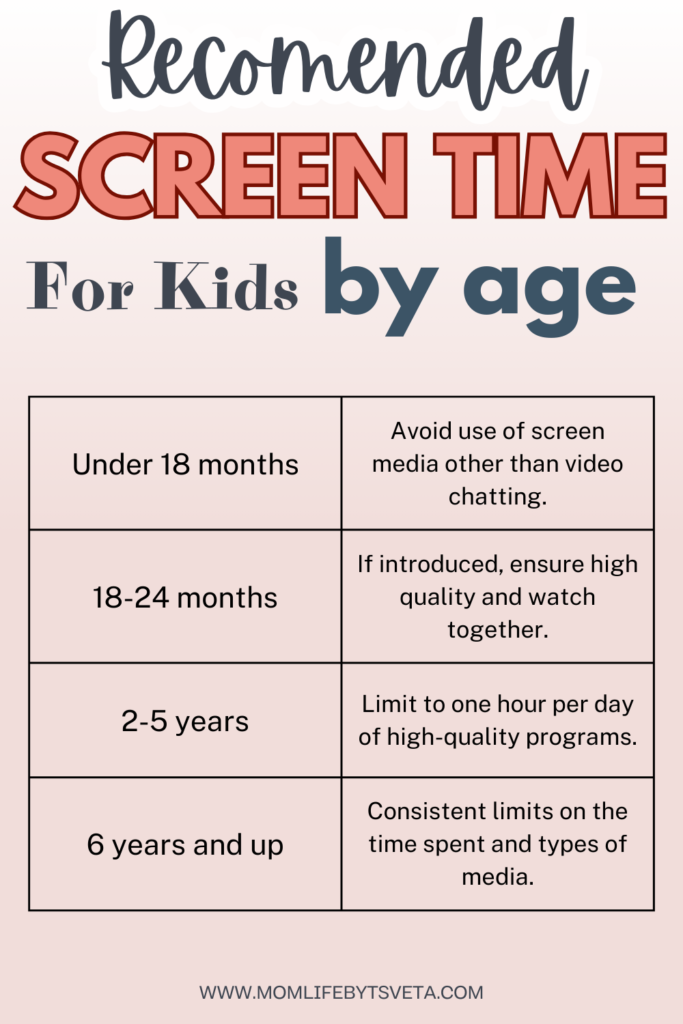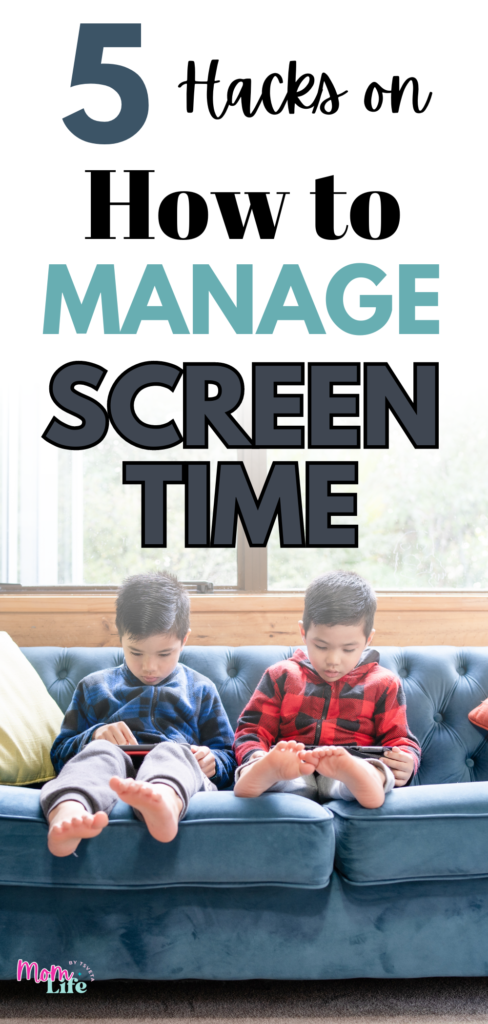Hey everyone! Navigating the digital world with kids can feel like sailing uncharted waters. We’re all trying to balance the right amount of screen time with essential real-world play.
As a mom of two young kids and a teacher on maternity leave, I’m right in the thick of it with you. I’m here to share some firsthand tips on managing tech while ensuring our kids still get to enjoy the simple joys of play. Let’s tackle this journey together, blending professional insights with real-life parenting experiences.
Table of Contents

Recomended Screen Time For Kids By Age
So, what’s the deal with kids and screen time? The American Academy of Pediatrics (AAP) really breaks it down for us. They recommend that kids between 2 and 5 years old should max out at one hour of screen time per day. But here’s the kicker—not all screen time is created equal.
Under 18 months: It’s best to avoid screen time for babies under 18 months, except for video chatting with family and friends. Babies and toddlers at this age learn best by interacting with people, not screens.
18-24 months: At this stage, if you choose to introduce digital media, make sure it’s high quality and something you can sit and engage with together. This helps them understand what they’re seeing.
2-5 years: Keep screen time to no more than one hour per day. Focus on high-quality educational content, and co-viewing is important to help young children understand and apply what they see on the screen to the world around them.
6 years and up: For older children, the key is to ensure consistent limits on both the amount and type of media they consume. Encourage a balanced day full of educational, physical, social, and recreational activities that are essential for healthy development.
What we’re talking about here is the impact different types of content can have. Watching an educational show that sparks a kid’s curiosity is a whole different ball game compared to passive video watching. Interactive, educational content? Now that’s the gold standard, helping our little ones learn and grow even while they’re in front of a screen.

Tips on How to Manage Screen Time
This section is all about sharing some practical tips for keeping screen time in check. We’re diving into how you can make tech use more meaningful and balanced for your kids.
Create a Family Media Plan
Putting together a family media plan totally changed the game for us, kind of like when we introduced chore charts to manage tasks. Think of it as setting up a GPS for navigating the digital world—everyone gets where we’re going. The trick? Make sure everyone gets a say, even my nearly 4-year-old. We turned it into a team project, discussing when screen time fits into our day and which apps are no-gos, similar to how we assign tasks on our chore charts.
It turned out to be a pretty fun activity, and it got her really pumped to be part of the decisions. Our motto became, “If it’s sunny, let’s skip the screen!” This approach really smoothed out the process of sticking to our plan and showed me just how impactful involving the kids can be. It’s way more than setting rules—it’s about building their understanding and sense of responsibility, just like with our chore charts.
Emphasize Quality Over Quantity
When it comes to screen time, what kids watch matters more than how long they’re watching. As a teacher-turned-full-time mom, I’ve learned that the right content can transform screen time from mindless to engaging.
Opt for educational apps that make learning fun, like storybook apps or math games. Favorites in our house include “Endless Alphabet” for learning letters through laughter and “PBS Kids” for a blend of everything from science to social skills. These aren’t just time-fillers; they’re digital playgrounds that stimulate curiosity and learning.
Remember, it’s about making screen time meaningful, not just monitoring the minutes. Engaging content can turn passive viewing into an interactive adventure.
Encourage Outdoor Play and Activities
Taking the kids outside is more than just a screen break—it’s key for their growth. Nothing beats fresh air and nature for active fun and development, way beyond what any app can provide. It’s also a perfect chance for family bonding and making lasting memories.
What’s our favorite outdoor activity? We love a backyard treasure hunt. My nearly 4-year-old gets a kick out of searching for “hidden treasures” like colorful leaves or smooth pebbles I’ve hidden. Even our littlest one joins in from his baby carrier, taking in all the sights and sounds, gearing up for future hunts.
This simple game does more than get our bodies moving; it lights up their eyes with joy and curiosity. It’s a clear reminder that the real treasures in life aren’t found on a screen—they’re out in the world, just waiting for us to discover them together.
Tech-Free Zones and Times
We made a simple rule at home: no screens at the dining table. It’s all about bringing back those stress-free family dinners, filled with real conversations about our days and sharing laughs.
Initially, it felt a bit awkward, like we were all meeting for the first time. But soon, it turned into the highlight of our day. We’re laughing more, sharing more, and not missing our screens at all.
This small change was easy to implement and made an immediate impact. Our meals have become about connecting deeply, proving that the best way to recharge is by unplugging.

Lead by Example
Leading by example with screen time is as tough as stopping at just one chip—it requires real self-discipline. Being on maternity leave has given me a chance to reassess my screen habits, and it’s been revealing. My kids are always watching and learning from me, whether it’s managing screen time or handling public tantrums.
I’ve made an effort to put away my phone during family time, focusing instead on being fully present, whether playing with my nearly 4-year-old or nursing the baby. The result? More cuddles, more laughs, and deeper conversations.
This small change hasn’t just improved our quality time; it’s teaching my kids that screens have their place but shouldn’t dominate our interactions. Plus, I’m more connected and less stressed. Setting a good example is beneficial for all of us, influencing how we handle everything, including public tantrums.
Conclusion
So, as we wrap this up, remember that managing screen time is really about balance and being intentional. Whether it’s setting up a solid media plan with your kids, picking out content that enriches, or establishing zones where tech is a no-go, each small step really does count.
As parents, when we lead by example, we show our kids the importance of being present and finding joy away from screens. We’re all in this together, exploring the perks of both digital and real-world play. Here’s to making every moment meaningful, both with and without screens.




[…] dinners that everyone actually enjoys. And while we’re at it, let’s not forget about managing screen time, which can totally change the dinner dynamics for the better. Ready to make this happen? Let’s […]